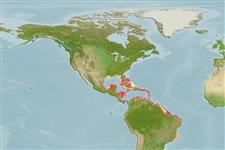>
Eupercaria/misc (Various families in series Eupercaria) >
Gerreidae (Mojarras)
Etymology: Gerres: Latin, gerres = a kind of anchovies; cited by Plinius.
More on author: Walbaum.
Environment: milieu / climate zone / depth range / distribution range
Ökologie
seewasser; süßwasser; brackwasser riff-verbunden; amphidrom (Ref. 51243); tiefenbereich 1 - 15 m (Ref. 9710). Subtropical; 33°N - 23°S, 98°W - 34°W
Western Atlantic: Bermuda and Florida, USA; Bahamas, northern Gulf of Mexico, around Caribbean, including Antilles and south American coast (Ref. 26938) to Rio de Janeiro, Brazil.
Length at first maturity / Size / Gewicht / Alter
Maturity: Lm 20.0, range 19 - ? cm
Max length : 41.0 cm TL Männchen/unbestimmt; (Ref. 7251); common length : 30.0 cm TL Männchen/unbestimmt; (Ref. 6077); max. veröff. Gewicht: 530.00 g (Ref. 40637)
Afterflossenstacheln 3; Afterflossenweichstrahlen: 7. Silvery with about seven faint pinkish bars on side on body; pelvic fins yellow (Ref. 13442).
Inhabits shallow coastal waters in open sandy and surf areas, seagrass beds, near reefs, and mangrove channels (Ref. 7251). Enters brackish water, sometimes even fresh water (Ref. 3722). May occur in small aggregations (Ref. 3722). Feeds on benthic invertebrates such as worms, clams, crustaceans (Ref. 3722); also feeds on insects (Ref. 9303). Often seen feeding in sand patches among reefs by thrusting its mouth into the sediment and expelling sand from the gill openings (Ref. 13442). Easily approached (Ref. 9710). Marketed fresh but not highly esteemed; also processed into fishmeal (Ref. 3722).
Life cycle and mating behavior
Geschlechtsreife | Fortpflanzung | Ablaichen | Eier | Fecundity | Larven
Bussing, W.A., 1995. Gerreidae. Mojarras. p. 1114-1128. In W. Fischer, F. Krupp, W. Schneider, C. Sommer, K.E. Carpenter and V. Niem (eds.) Guia FAO para Identification de Especies para lo Fines de la Pesca. Pacifico Centro-Oriental. 3 Vols. FAO, Rome. (Ref. 9303)
IUCN Rote Liste Status (Ref. 130435)
Bedrohung für Menschen
Reports of ciguatera poisoning (Ref. 30911)
Nutzung durch Menschen
Fischereien: weniger kommerziell; Köder: occasionally
Mehr Information
ReferenzenAquakulturAquakultur ProfilZuchtlinienGenetikElectrophoresesVererbbarkeitKrankheitenVerarbeitungNutrientsMass conversion
Tools
Zusatzinformationen
Download XML
Internet Quellen
Estimates based on models
Preferred temperature (Ref.
123201): 23.4 - 28.1, mean 27.3 °C (based on 792 cells).
Phylogenetic diversity index (Ref.
82804): PD
50 = 0.5000 [Uniqueness, from 0.5 = low to 2.0 = high].
Bayesian length-weight: a=0.01318 (0.01026 - 0.01693), b=3.05 (3.01 - 3.09), in cm total length, based on LWR estimates for this species (Ref.
93245).
Trophic level (Ref.
69278): 3.5 ±0.2 se; based on diet studies.
Widerstandsfähigkeit (Ref.
120179): mittel, Verdopplung der Population dauert 1,4 - 4,4 Jahre. (K=0.60; tm=1.5).
Fishing Vulnerability (Ref.
59153): Low vulnerability (24 of 100).
Nutrients (Ref.
124155): Calcium = 38.3 [14.7, 84.5] mg/100g; Iron = 0.618 [0.273, 1.172] mg/100g; Protein = 20.5 [18.5, 22.5] %; Omega3 = 0.209 [0.106, 0.425] g/100g; Selenium = 12.5 [5.7, 26.9] μg/100g; VitaminA = 30.3 [7.2, 118.1] μg/100g; Zinc = 0.917 [0.561, 1.436] mg/100g (wet weight);
